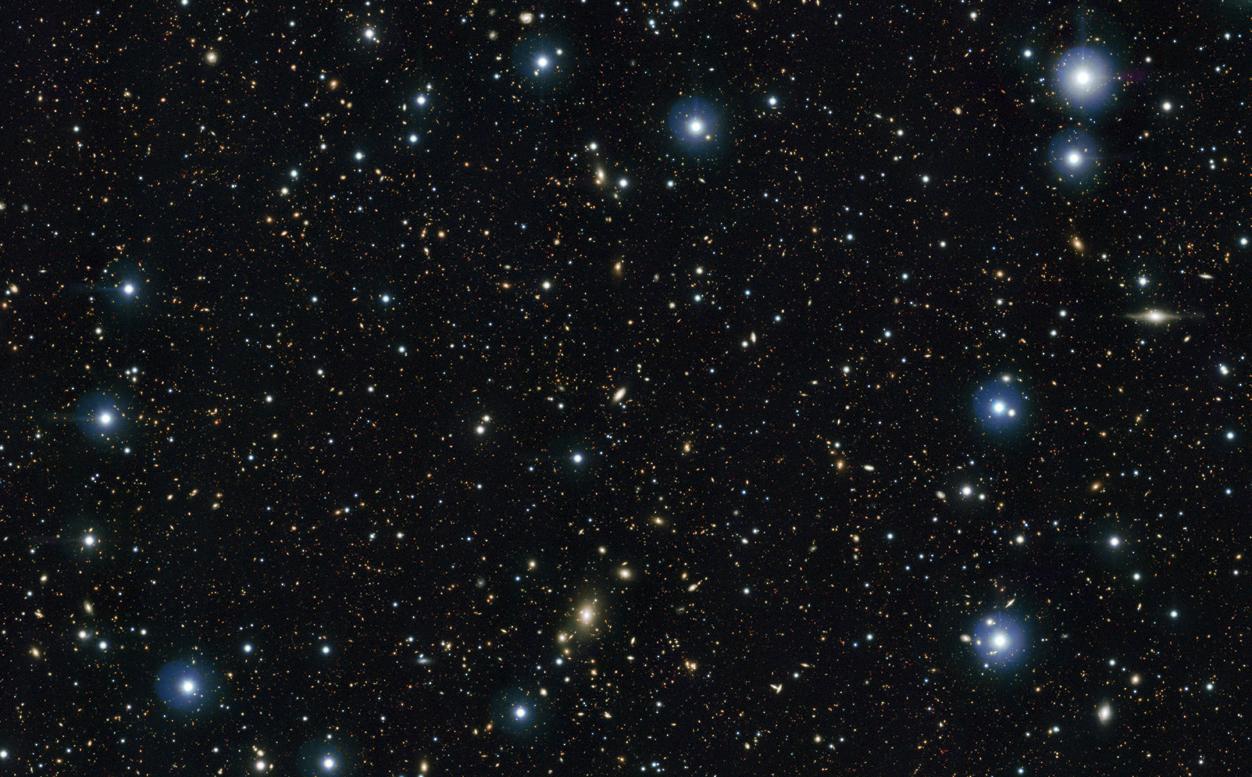Team members: Bianca Garilli, Marco Scodeggio, Lucio Chiappetti, Dario Bottini, Mari Polletta, Paolo Franzetti, Marco Fumana, Adriana Gargiulo, Dario Maccagni, Letizia Cassarà

Multi-band infrared image (Blue=1μm, Green=1.3μm, Red=2.2μm) of the 1.7 square deg COSMOS field obtained with the ESO/VISTA telescope at Paranal Observatory. Total exposure time of 55 hours. More than 200,000 galaxies have been identified in this image. Credit: ESO/UltraVISTA Team/TERAPIX/CNRS/INSU/CASU.
The research activity of the group is focused on understanding the evolution of galaxies from the assembly epoch to the present time, and it is primarily based on the statistical analysis of multi-wavelength spectro-photometric data from large galaxy redshift surveys. We are especially interested in tracing the evolution of star formation activity in galaxies and understanding the processes that might trigger, regulate, or terminate it. Emphasis is given to the study of various star formation rate indicators, of the role of the environment and of active galactic nuclei in regulating galaxy evolution, of the transition from star-forming to passive galaxies. Our expertise includes the development of analysis tools to measure spectral properties, to characterize the spectral energy distribution of galaxies and active galactic nuclei from ultraviolet to far-infrared wavelengths using stellar synthesis population models, to study the evolution of metallicity and dust content in galaxies.
The main projects we are currently involved with include a number of ongoing (or recently completed) surveys, plus some future surveys still at the planning stage
| VANDELS: a deep VIMOS survey of the CANDELS UDS and CDFS fields Deep VLT spectroscopic survey of high-redshift galaxies in the CANDELS fields with the VIMOS spectrograph, designed to produce high signal-to-noise spectra and investigate the physiscs of galaxies in the early Universe. | VANDELS Home Page |
| VIPERS: the VIMOS Public Extragalactic Redshift Survey An ESO Large Program survey with the VIMOS spectrograph, which has collected some 90,000 galaxy redshift measurements over an area of 24 square degrees, to study the details of the galaxies large-scale distribution. | VIPERS Home Page |
| VUDS: the VIMOS Ultra Deep Survey An ESO Legacy Large Program designed to make a complete census of the star forming galaxy population at 2 < z < 6.7 by observing 10000 galaxies with the VIMOS spectrograph. | VUDS Home Page |
| The MOONS extra-galactic survey (planned) A spectroscopic survey being designed to primarily study galaxy evolution in the redshift range 2 < z < 6 | MOONS IASF Page |
| The Euclid spectroscopic survey (planned) A spectroscopic survey being designed to primarily map the large-scale distribution of galaxies in the redshift range 0.9 < z < 1.8 with observations of some 30 Million galaxies over 15,000 square degrees | Euclid IASF Page |
Past spectroscopic surveys we have been involved with include
| VVDS: the VIMOS VLT Deep Survey The first spectroscopic survey carried out with the VIMOS spectrograph on the ESO/VLT. It includes observations of some 35,000 galaxies in the redshift range 0 < z < 6.5 | VVDS Home Page |
| zCOSMOS: the redshift survey in the COSMOS field A combination of a Wide and a Deep survey, with observations of some 20,000 and XXXX galaxies, respectively, carried out with the VIMOS spectrograph. | zCOSMOS ESO Page |
| MASSIV: the Mass Assembly Survey with SINFONI in VVDS A high-resolution spectroscopic survey of 84 star-forming galaxies drawn from the VVDS sample in the redshift range 0.9 < z < 2.2 designed to study the formation phase of galaxy disks. | MASSIV Database |
| CLASH-VLT: a VLT survey of CLASH clusters A spectroscopic survey of 14 massive clusters of galaxies in the redshift range 0.2 < z < 0.6, carried out with the VIMOS spectrograph. | CLASH-VLT Home Page |
Other survey projects some of us are (or were, until recently) involved with include
| COSMOS: the Cosmic Evolution Survey a multi-wavelength observational effort, covering an area of 2 square degrees with observations from the X-rays (XMM-Newton and Chandra) and the UV (GALEX) to the optical (from the ground using SUBARU and the CFHT, and from space using ACS on board HST), the Near and Mid-infrared (Spitzer and Herschel), the sub-millimiter and the radio (VLA) wavelengths. Over 2 million galaxies, spanning 75% of the age of the Universe, have been detected by this project. | COSMOS Home Page |
| DustPedia: A Definitive Study of Cosmic Dust in the Local Universe A study of dust content in nearby galaxies, based primarily on data from the Herschel and Planck satellites | DustPedia Home Page |
| XXL and XMM-LSS Two X-ray surveys carried out with XMM-Newton, designed to probe the large scale distribution of clusters of galaxies out to z ~ 1, and of QSOs much further out. | XXL IASF Page |
A list of the most recent papers we have worked on can be obtained from the ADS new query form
We also develop new software tools for data reduction and analysis (see the Astronomical Software page).
